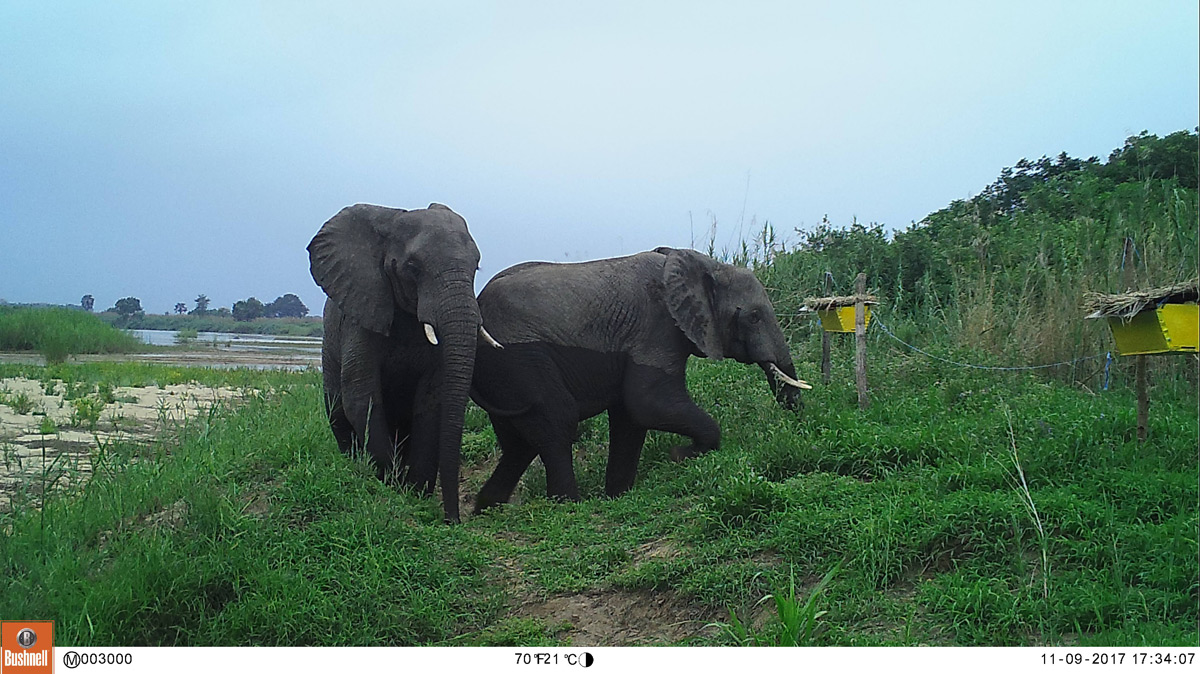This article was written by Leigh Cooper in University of Idaho Communications and Marketing. View the original article here. While IMCI was not involved in the funding of this research project, we are are thrilled to count Dr. Ryan Long as one of our participating faculty.
MOSCOW, Idaho – October 17, 2019 – A University of Idaho-led team of researchers found that experimental fences reduced the number of times elephants left Mozambique’s Gorongosa National Park to raid nearby crops by 80-95%; beehive fences appeared to be the most effective at deterring crop raiding while also providing a revenue source for neighboring villages through the production of honey.

The team’s evaluation of various fencing strategies for discouraging crop raiding by elephants outside Gorongosa was published today in Conservation Letters.
Crop raiding by wildlife results in billions of dollars in economic losses globally and threatens wildlife conservation efforts by creating negative human attitudes toward wildlife. Human and wildlife conflict can be exacerbated near protected areas like Gorongosa National Park, where the elephant population has risen to roughly 600 after falling by more than 90% during a civil war in the 1970s-90s.
“The better the elephant population does, the more animals leave the park and raid crops. That becomes a legitimate issue for the people living near the park as they are mostly subsistence farmers,” said Ryan Long, a U of I assistant professor and a lead researcher on the paper. “Negative interactions can lead to elephants being killed by people, or people being killed by elephants.”
Long, master’s student Paola Branco and colleagues tested the effectiveness of different fences at discouraging elephants from leaving the park. The study area incorporated four communities along 11.6 miles of the Pungue River, which marks the park’s southern border. The team fenced 13 of the 18 elephant river crossings in the study area. They used multiple fence types including beehive fences — free-swinging hives connected with twine — and chili fences — woven fabric soaked with chili-infused vegetable oil.
The researchers tracked elephant movements through GPS collars placed on 12 male elephants, camera-trap data and local reporting; they compared the number of elephant crossings in fall 2016 before fences were erected to the number of elephant crossings in fall 2017 when fences were in place. The number of crossings in the study area fell from 67 to 32, and the mean number of crossings at fenced locations decreased from 4.4 to 1.0.
The beehive fences appeared to be the most effective deterrent — a 95% reduction in crossings was observed — although the small sample size didn’t allow for statistical differentiation among fence types, Long said. The study indicates various fences can reduce crop raiding, and working with local communities to modify animal behavior and human attitudes simultaneously can mitigate human and wildlife conflict.
“To be effective, mitigation must be affordable and maintained locally. There must be an incentive to maintain them, and they need to improve the perception of wildlife by locals,” Long said. “We picked these fences because, first, it’s cost-prohibitive to create a physical barrier to stop the largest land mammal on Earth, especially across a large area. Secondly, there’s intrinsic motivation for the communities to maintain these fences over the long term, both for the purpose of deterring elephants and for the purpose of producing a marketable product, honey.”
The initial cost of fence construction was borne by the park and donors, while local communities were responsible for maintenance and harvest and sale of the honey. A beehive fence with 15 hives, like the ones used in the study, can generate from two to four times the current minimum annual wage in Mozambique. Based on the study’s results, the Conservation Department of Gorongosa is now deploying beehive fences at crossings all along the Pungue River.
This project was funded under National Science Foundation award 1656642. The total project funding is $700,000, of which 100% is the federal share.
—
Media Contacts
Ryan Long
Assistant Professor of Wildlife Sciences
Department of Fish and Wildlife Sciences
208-885-7225
ralong@uidaho.edu
Leigh Cooper
Science and Content Writer
University of Idaho Communications and Marketing
208-885-1048
leighc@uidaho.edu
About the University of Idaho
The University of Idaho, home of the Vandals, is Idaho’s land-grant, national research university. From its residential campus in Moscow, U of I serves the state of Idaho through educational centers in Boise, Coeur d’Alene and Idaho Falls, nine research and Extension centers, plus Extension offices in 42 counties. Home to nearly 12,000 students statewide, U of I is a leader in student-centered learning and excels at interdisciplinary research, service to businesses and communities, and in advancing diversity, citizenship and global outreach. U of I competes in the Big Sky Conference. Learn more at uidaho.edu
